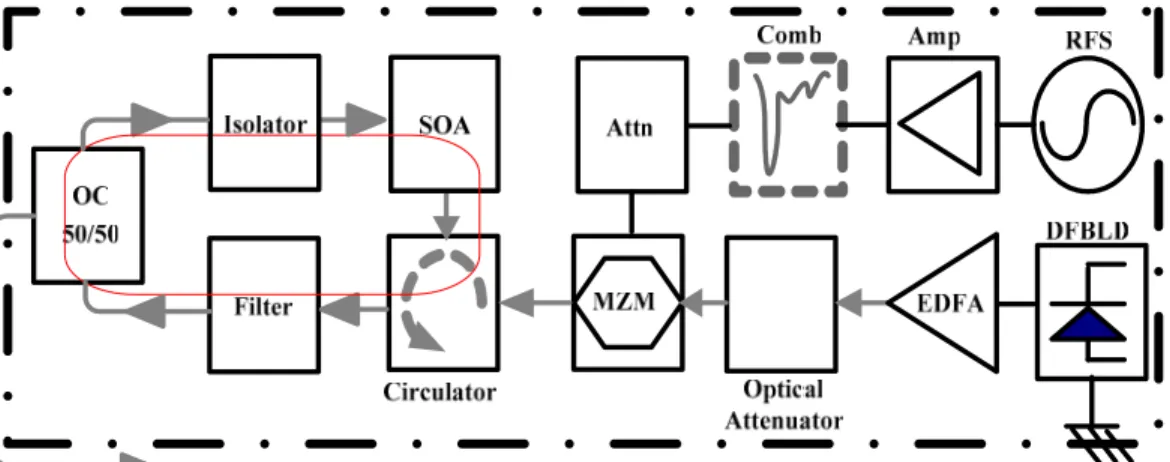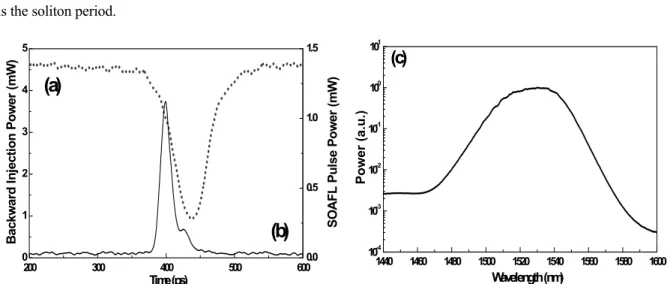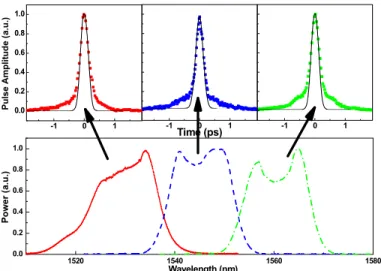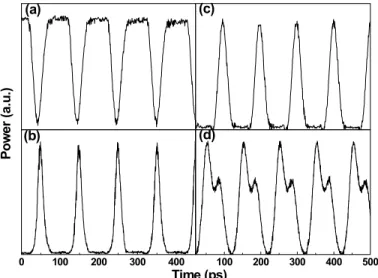Femtosecond harmonic optical-Injection mode-locked semiconductor
optical amplifier based fiber lasers
Yu-Sheng Liao
a, I-Shiang Chiu
a, and Gong-Ru Lin
*ba
Department of Photonics & Institute of Electro-Optical Engineering,
National Chiao Tung University, No. 1001, Ta Hsueh Rd., Hsinchu 300, Taiwan, R.O.C.;
bGraduate Institute of Electro-Optical Engineering, Department of Electrical Engineering,
National Taiwan University, No.1, Roosevelt Road Sec. 4, Taipei 106, Taiwan, R.O.C.
ABSTRACT
A 30nm wavelength-tunable backward dark-optical-comb injection-mode-locked semiconductor optical amplifier fiber laser (SOAFL) with pedestal-free is reported after high-order soliton compression with maximum pulse compression ratio of up to 80. Shortest mode-locked SOAFL pulsewidth of 15 ps at 1 GHz is generated, which can further be compressed to 180 fs after linear chirp compensation, nonlinear soliton compression, and birefringent filtering. The pedestal-free eighth-order soliton can be obtained by injecting the amplified pulse with peak power of 51 W into a 107.5m-long single-mode fiber (SMF), providing a linewidth and timebandwidth product of 13.8 nm and 0.31, respectively. The tolerance in SMF length is relatively large (100-300 m) for obtaining <200fs SOAFL pulsewidth at wavelength tuning range of 1530-1560 nm. By extending the repetition frequency of dark-optical-comb up to 10 GHz, the mode-locked SOAFL pulsewidth can be slightly shortened from 5.4 ps to 3.9 ps after dispersion compensating, and further to 400 fs after second-order soliton compression. The lasing linewidth, time-bandwidth product and pulsewidth suppressing ratio of the SOAFL soliton become 4.5 nm, 0.33, and 10, respectively.
Keywords: SOA, mode-lock, fiber laser, soliton, chirp, pulse compensation
*Corresponding Author. E-mail: grlin@ntu.edu.tw; Phone: 886 2 33663700 ext.235; Fax: 886 2 23677467
1. INTRODUCTION
Mode-locked semiconductor amplifier based fiber lasers are possible candidates for high-bit-rate optical carriers in high-speed optical communication systems. It is known that harmonically mode-locking technology is one of the most intriguing methods for generating laser pulses with high repetition rate. However, in typical harmonically mode-locked fiber ring laser, maximum pulse repetition rate is limited by the bandwidth of intracavity LiNbO3
modulating components was relaxed by using rational harmonic mode-locking [1], or frequency multiplication with modulator nonlinearity techniques [2, 3]. More recently, pulses repetition frequency in FM mode-locked fiber lasers can be increased via a fiber Fabry-Perot filter (FFP) based wavelength selecting and filtering technique within the laser cavity. Pulsed fiber optical sources with pulsewidth of some picoseconds and GHz repetition frequencies are of great interest in particular for the development of high speed optical communication systems. For experimental systems to be installed in the laboratory, the required sources are with wide tunability of wavelength, pulse width and repetition rate. Mode-locked semiconductor amplifier based lasers are possible candidates for optical carriers in high-speed optical communication systems. It is known that harmonically mode-locking technology is one of the most intriguing methods for generating pulses with high repetition rate. At frequencies of several tens of gigahertz, the low cost of electronics signal sources make optical techniques attractive for generating high repetition-rate optical pulses. Different approaches include multiplying the repetition-rate of a lower frequency optical pulse-train or high-order mode-locking of a fiber ring laser. However, most of wavelength tunable short pulse generation techniques have used active mode locking of an erbium doped fiber ring laser with lithium niobate modulator and wavelength tunable filter.
Optically cross-gain-modulation (XGM) mode-locked semiconductor optical amplifier fiber laser (SOAFL) with a highest repetition rate up to 50 GHz [4], a shortest pulsewidth of 1.2 ps [5], and a wide wavelength tuning range of ~20 nm [4] have been reported. Nonetheless, it is found that most XGM mode-locked SOAFL systems generate pulses in picosecond regime [5-8], whereas no femtosecond outputs of such systems were investigated. In this paper, we study the femtosecond soliton compression dynamics, the wavelength tuning and high-repetition frequency results of a backward dark-optical-comb injection induction XGM mode-locked SOAFL.
2. EXPERIMENTAL SETUP
Figure 1 illustrates the backward optical-injection mode-locked SOAFL system with a ring cavity length of 14 m, which consists of one traveling-wave typed polarization insensitive SOA, an optical circulator, a faraday isolator, a polarizer, an 50% output coupler (OC), an optical tunable band-pass filter (OBPF), a quarter-wave plate, and a polarization controller. The SOA with central wavelength of 1530 nm and spectral linewidth of 35 nm shown in Fig. 2(c), was DC biased at 345 mA (well above its transparent current of 50 mA).
L!WL
I{L
coIJJp J/\IXLl\Ioc
mb
C!Ld11POL U ObWJI VGIJfl1O] poP1o]L DEBFIThroughput
Power
a h —Fig. 1 Schematic diagram of the backward optical-injection mode-locked SOAFL based femtosecond soliton generator. Amp: microwave amplifier; ISO: isolator.
To backward optical-inject the SOA for harmonic mode-locking, a butterfly-packaged distributed feedback laser diode (DFBLD) operated at 70 mA, 1535 nm, and 25oC was amplified by an erbium-doped fiber amplifier (EDFA)
with 20dB gain and externally modulated by a Mach-Zehnder intensity modulator (MZM). An electrical comb generator (Comb) used to drive the MZM is triggered by an amplified radio-frequency synthesizer (RFS) signal with power of 29 dBm. By operating the DC-bias level of the MZM at ~0.2 Vπ, a dark-optical-comb with average power
and pulsewidth of 4.5 mW and ≤60 ps, respectively, can be obtained at the MZM output, as illustrated in Fig. 2. The COMB is operated at input power of 29 dBm by using an RF synthesizer (Rohde&Schwarz SML01) in connection with a power amplifier of 40-dB gain. By changing the DC-bias level of the MZM at 1.2 V and 0.3 Vπ, the bright-
and dark-optical combs with pulsewidth of ≤60 ps can be obtained at the MZM output, as illustrated in Fig. 2.
(A)
(B)
Fig. 2 The driving points of Mach-Zehnder modulator for (A)
dark- and (B) bright-optical combs. Fig. 3 The (A) dark- and (B) bright-optical combs.
The average powers of the bright- and dark-optical combs, as illustrated in Fig. 3, injected into the SOAFL are 0.61 mW and 4.46 mW, respectively. The dark-optical comb is backward injected into the SOAFL via the optical circulator, which then induces a gain-depletion modulation depth of nearly 100% under fine adjustment of the SOA
driving current. In contrast, the bright-optical-comb injected SOAFL leaves much residual gain in the SOA. The use of the isolator and OBPF ensure unidirectional propagation and avoid the lasing of the injected optical-comb in the SOAFL. The harmonic mode-locking is achieved when the repetition frequency of the injected dark-optical comb exactly coincides with one harmonic longitudinal-mode frequency of the SOAFL. The dark optical-comb is backward injected into the SOAFL via an optical circulator, which then induces a gain-depletion modulation depth of nearly 100% under fine adjustment of the SOA driving current.
3. RESULTS AND DISCUSSIONS
In practice, soliton-effect compression is carried out by initially amplifying optical pulses up to power level required for the formation of higher order solitons. The peak optical power of the initial pulse required for the formation of an Nth -order soliton is given by
2 2 2 2 2 2 3.11 2 11 . 3
γτ
β
γτ
π
λ
N c D N PN = = (1) where β2 is the GVD parameter in units of ps2/Km, γ is the fiber non-linearity coefficient associated with SPM in unitsof W-1Km-1, τ is the Full-Width at Half-Maximum (FWHM) of the initial optical pulse, N is the soliton order, D is the
fiber dispersion parameter, λ is the optical wavelength, c is the velocity, and PN is the peak power required to excite the Nth -order soliton in the fiber. These Nth -order solitons are then passed through the correct length of optical fiber to finally yield highly compressed pulses. In general, the higher the order N, the shorter the length of fiber required for the compression process [9]. The optical soliton is the result of interaction betweenthe group velocity dispersion (GVD) and the self-phasebmodulation (SPM) effects in a fiber with anomalous dispersion. The soliton theory shows that for pulses with a sech2 profile and appropriate peak power, the two effects can cooperate in such a way that the
fundamental solitons will travel in a lossless fiber without any temporal and spectral changes due to the balanced effects, and the higher order solitons will follow a periodic evolution patter, with the original shape recurring at multiples of the soliton period Z0. During the propagation of higher order solitons, SPM generates a frequency chirp
such that the leading edge is red shifted and the trailing edge is blue shifted from the central frequency, while at the same time, the anomalous GVD will compensate for such frequency chirping at a certain propagation distance, resulting in a pulse compression over the central part of the pulse. The soliton-effect compression is due to the initial narrowing phase through which all higher order solitons go before the initial shape is restored after one soliton period. A crucial point for the successful realization of the soliton-effect compression is the appropriate choice of the fiber length to obtain optimum compression because the higher order solitons follow a periodic evolution pattern such that they go through an initial narrowing phase at the beginning of each period. The optimum fiber length Zopt corresponds
to the location at which the width of the central spike is minimum. From the theoretical analysis in [10], we found that the optimum soliton effects, the pulse narrowing is defined about z0 where
2 0 0.332 ⎟ ⎠ ⎞ ⎜ ⎝ ⎛ = λ τπ D c Z (2)
is the soliton period.
200 300 400 500 600 0 1 2 3 4 5 0.0 0.5 1.0 1.5
(a)
(b)
B ac kw ar d In je ct io n P o w er ( m W ) Time (ps) S O A F L Pu ls e Po w er ( mW ) 1440 1460 1480 1500 1520 1540 1560 1580 1600 10-4 10-3 10-2 10-1 100 101 P ow er ( a. u. ) Wavelength (nm)(c)
Fig. 4 Upper: pulse shapes of the (a) injected dark-optical-comb and (b) mode-locked SOAFL; Lower: (c) the amplified spontaneous emission spectrum of SOA operated at 15oC.
With a backward dark-optical-comb injection waveform shown in Fig. 4(a), the optimized mode-locking result of the SOAFL is illustrated in Fig. 4(b). At a repetition frequency of 1 GHz, the spectral linewidth and average power of the SOAFL are 0.45 nm and 0.1 mW, respectively. Figure 5 reveals the unchanged spectrum of the DCF compensated pulse, which is coincident with that of the original mode-locked pulse. In comparison, Kim et al. have ever observed the compression from 18.4 ps to 6.8 ps after passing through a 2-km SMF, which exhibits the linewidth and time-bandwidth product (TBP) of 0.5 nm and 0.44, respectively [7]. In our case, the pulsewidth is compressed from 15 ps to 8.6 ps with a reduced TBP of 0.48 after propagating through a 420m-long DCF.
-20 0 20 40 60 0.0 0.2 0.4 0.6 0.8 1.0 1529.6 1530.0 1530.4 0.0 0.2 0.4 0.6 0.8 1.0 P u ls e A m p litu d e (a .u .) Time (ps) S p ec tral P o w er (a .u .) Wavelength (nm) -2 -1 0 1 2 0.0 0.2 0.4 0.6 0.8 1.0 216 fs198 fs 180 fs P o we r (a .u .) Time (ps)
Fig. 5 Left: Auto-correlated traces and lasing spectra of SOAFL pulse at 1 GHz before and after chirp compensation. Right: original (dotted), partially birefringent filtered (dashed) and completely filtered (solid) soliton pulses
of 440 mW at repetition frequency of 1 GHz (corresponding to a peak power of 51 W) for generating an eighth-order soliton (N = 8) in a SMF with D = 20 ps/km/nm at 1.55 µm. The optimized fiber length to obtain the shortest eighth-order soliton compression would thus be 107.5 m (or equivalent to 0.072Z0 theoretically, where the estimated
soliton period Z0 is about 1.6 km at 1550 nm) in our case. To completely suppress these pedestals shown in Fig. 6, an
intensity discrimination scheme that relies upon the intensity dependent polarization state of light in the fiber is utilized in our work [11, 12]. As a result, a polarization-purified pulse shape after soliton compression can be completely pedestal-free and further shortened to 180 fs after a polarizer. The linewidth and time-bandwidth product of the eighth-order SOAFL soliton pulse become 13.8 nm (∆ν=1.7 THz) and 0.31, respectively.
1520 1540 1560 1580 0.0 0.2 0.4 0.6 0.8 1.0 -1 0 1 0.0 0.2 0.4 0.6 0.8 1.0 -1 0 1 Po wer ( a.u .) Wavelength (nm) -1 0 1 Puls e Amplit ud e ( a .u .) Time (ps)
Fig. 6 Pulses and associated spectra at different wavelengths.
The average power of the SOAFL pulse after soliton compressing and birefringent filtering can be as high as 25.2 dBm, corresponding to a peak pulse power of 1 kW at repetition frequency of 1 GHz. Such an optically mode-locked SOAFL can provide picosecond pulses over a wide wavelength range of up to 30 nm, as shown in Fig. 7. By setting the backward injection wavelengths at 1535 nm, 1549 nm, and 1565 nm, the optimized mode-locking of the SOAFL at wavelengths of 1530 nm, 1545 nm, and 1560 nm can be achieved. As a result, the nonlinear compressed pulsewidth and linewidth of the SOAFL are 190±10 fs and 13.7±0.1 nm, respectively. The TBP can be controlled at 0.31~0.34.
0 100 200 300 400 100 200 300 400 500 (a) (c) (b) (d) Time (ps) P o w er (a .u .)
Fig.7 Backward injected (a) dark- and (b) bright-optical- combs, and their resulting mode-locked SOAFL pulse-trains shown in (c) and (d), respectively.
The optimized mode-locking SOAFL with shortest pulsewidth of 5.4 ps and peak power of 2.5 mW by injecting the SOA with a 25-ps wide dark-optical-comb at repetition rate of 10 GHz is shown in Fig. 7(a) and 7(b). In comparison, there was only a report for generating a nearly transform-limited 4.3-ps pulse-train over a 16-nm tuning range from a similar SOAFL system repeated at 10 GHz under the injection of the 15-ps gain-switched and DCF compressed DFBLD pulses like a bright-optical-comb shown in Fig. 7(c) [5]. Such a short-pulsewidth bright-optical-comb injection usually fails to induce sufficient modulation depth in the SOA, giving rise to a mode-locking with a secondary pulse shown in Fig. 7(d). The linearly compensated and nonlinearly soliton compressed SOAFL pulse shapes after passing through DCF and SMF are shown in Fig. 8.
-20 -15 -10 -5 0 5 10 15 20 0.0 0.2 0.4 0.6 0.8 1.0 mode-locked dispersion compensation soliton compression Pow er ( a. u .) Time (ps) 1548 1550 1552 1554 1556 1558 1560 1562 0.0 0.2 0.4 0.6 0.8 1.0 P ow er (a.u.) Wavelength (nm) (d)
Fig. 8 Pulse shape (left) and spectra (right) of Mode-locked (dotted), dispersion compensated (dashed), and soliton compressed (solid) SOAFL pulse shapes 10 GHz
The spectral linewidth and time-bandwidth product of the original mode-locked SOAFL pulse are 0.9 nm and 0.61, respectively. The mode-locked SOAFL pulsewidth can be slightly shortened to 3.9 ps with a 75m-long DCF. With an average
power of 1.7 W, the pulsewidth, linewidth and time-bandwidth product of 400 fs, 4.5 nm and 0.33, respectively, is observed after second-order soliton compressing in a 76.7m-long SMF. The inevitable broadening of the compressed pulsewidth at 10 GHz as compared to that at 1 GHz is mainly attributed to the lower obtainable peak power (about 11 W) at higher repetition frequency and the shorter pulsewidth obtained at the DCF compensating stage, which concurrently result in the decreasing soliton order.
4. CONCULSION
We primarily demonstrate femtosecond pulse compression of a wavelength-tunable, backward dark-optical-comb injection harmonic-mode-locked semiconductor optical amplifier based fiber laser (SOAFL). Shortest mode-locked SOAFL pulsewidth of 15 ps at 1 GHz is compressed to 180 fs after linear chirp compensation, eighth-order nonlinear soliton compression, and birefringent filtering. A maximum pulsewidth compression ratio of up to 80 is reported. The pedestal-free eighth-order soliton exhibits linewidth and time-bandwidth product of 13.8 nm and 0.31, respectively. At 10 GHz, the mode-locked SOAFL pulsewidth can be slightly shortened from 5.4 ps to 3.9 ps after dispersion compensating, and further to 400 fs after second-order soliton compression associated with linewidth, time-bandwidth product and pulsewidth suppressing ratio of 4.5 nm, 0.33, and 10, respectively.
ACKNOWLEDGEMENT
The work was support in part by National Science Council, Taiwan Republic of China under grants No. NSC94-2215-E-009-040 and No. NSC95-2215-E-002-0XX.
REFERENCE
1. Z. Ahmed, and N. Onodera, “High repetition rate optical pulse generation by frequency multiplication in actively modelocked fibre ring lasers,” IEE Electron. Lett., 32, 455-457, (1996).
2. T. Pfeiffer and G. Veith, “40 GHz pulse generation using a widely tunable all polarization preserving erbium fiber ring laser,” IEE Electron. Lett., 29, 1849-1850, (1993).
3. K. K. Gupta and D. Novak, “Millimeter-wave repetition-rate optical pulse train generation in harmonically modelocked fiber ring laser,” IEE Electron. Lett., 33, 1330-1331, (1997).
4. Kyriakos Vlahos, Chris Bintjas, Nikos Pleros, and Hercules Avramopoulos, “Ultrafast semiconductor-based fiber laser sources,” IEEE Journal Of Selected Topics In Quantum Electronics, 10, 147-153, (2004).
5. T. Papakyriakopoulos, K. Vlachos, A. Hatziefremidis, and H. Avramopoulos, “20-GHz broadly tunable and stable mode-locked semiconductor amplifier fiber ring laser” Opt. Lett., 24, 1209-1211, (1999).
6. G..-R. Lin, Y.-S. Liao, and G..-Q. Xia, “Dynamics of optical backward-injection-induced gain-depletion modulation and mode locking in semiconductor optical amplifier fiber lasers,” Opt. Express, 12, 2017-2026, (2004).
7. D. H. Kim, S. H. Kim, Y. M. Jhon, S. Y. Ko, J. C. Jo, and S. S. Choi, “Relaxation-Free Harmonically Mode-Locked Semiconductor-Fiber Ring Laser,” IEEE Photon. Technol. Lett. 11, 521-523, (1999).
8. G.-R. Lin, I H. Chiu, and M. C. Wu, “1.2-ps mode-locked semiconductor optical amplifier fiber laser pulses generated by 60-ps backward dark-optical comb injection and soliton compression,” Optics Express, 13, 1008, (2005).
9. E. M. Dianov, A.Ya. Karasik, P. V. Mamyshec, G. I. Onischukov, A. M. Prokhorov, and A. A. Fomichev, JETP Lett., 40, 903, (1984).
10. L. F. Mollenauer, R. H. Stolen, J. P. Gordon, and W. J. Tomlinson, “Extreme picosecond pulse narrowing by means of soliton effect in single-mode optical fiber,” Opt. Lett., 8, 289-291, (1983).
11. K. A. Ahmed, K. C. Chan, and H. F. Liu, “Femtosecond pulse generation from semiconductor lasers using the soliton-effect compression techique,” IEEE J. Quantum Electron., 1, 592-600, (1995).
12. H. F. Liu., Y. Ogawa, S. Oshiba, and T. Tonaka, “Picosecond Pulse Generation from a1.3um Distributed Feedback Laser Diode Using Soliton-effect Compression,” IEEE J. Quantum Electron. 27, (1991).



